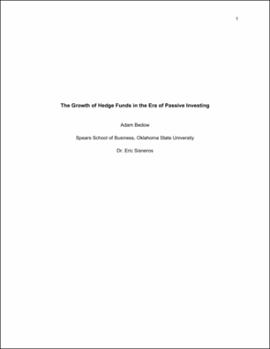| dc.description.abstract | In 2007, Warren Buffet made a bet with Protege Partners that the SP 500 Index would outperform any chosen 5 Hedge funds over the next decade. After 10 years, $1 million invested in the hedge funds would have gained $220,000 vs $854,000 for the S&P 500 (Floyd, 2021). It is safe to say that Buffet won the bet, and many took this as clear proof that passive investing is superior to active investing. The prevailing sentiment among academics and many market participants is that Hedge Funds are an inefficient investment vehicle that are unable to justify their fees with their recent performance. While this famous bet and other performance data over the last decade would seem to solidify the case against hedge funds, hedge fund assets under management have grown from $1.5 trillion in 2008 to nearly $5 trillion now. Investors are pouring more money than ever into this alternate asset class, despite the common belief that it is an inefficient investment. While it is true that hedge funds have not performed nearly as well in the last 15 years as in decades prior, there are still several valid reasons for continued investment in hedge funds. Among these reasons are returns being understated by reporting methods, diversification benefits, especially in certain strategies, a possibility of a macro-shift in the performance of different asset classes, and allocation requirements for institutional investors. The research shows that almost any kind of institutional investor can benefit from at least one of the many hedge fund strategies out there. Some funds still outperform the market, certain strategies provide strong correlation benefits, and some provide access to niche investments. Whether an investor is looking for alpha generation, reduced risk, or to diversify their portfolio, there is a hedge fund out there that can fit their needs. | |
